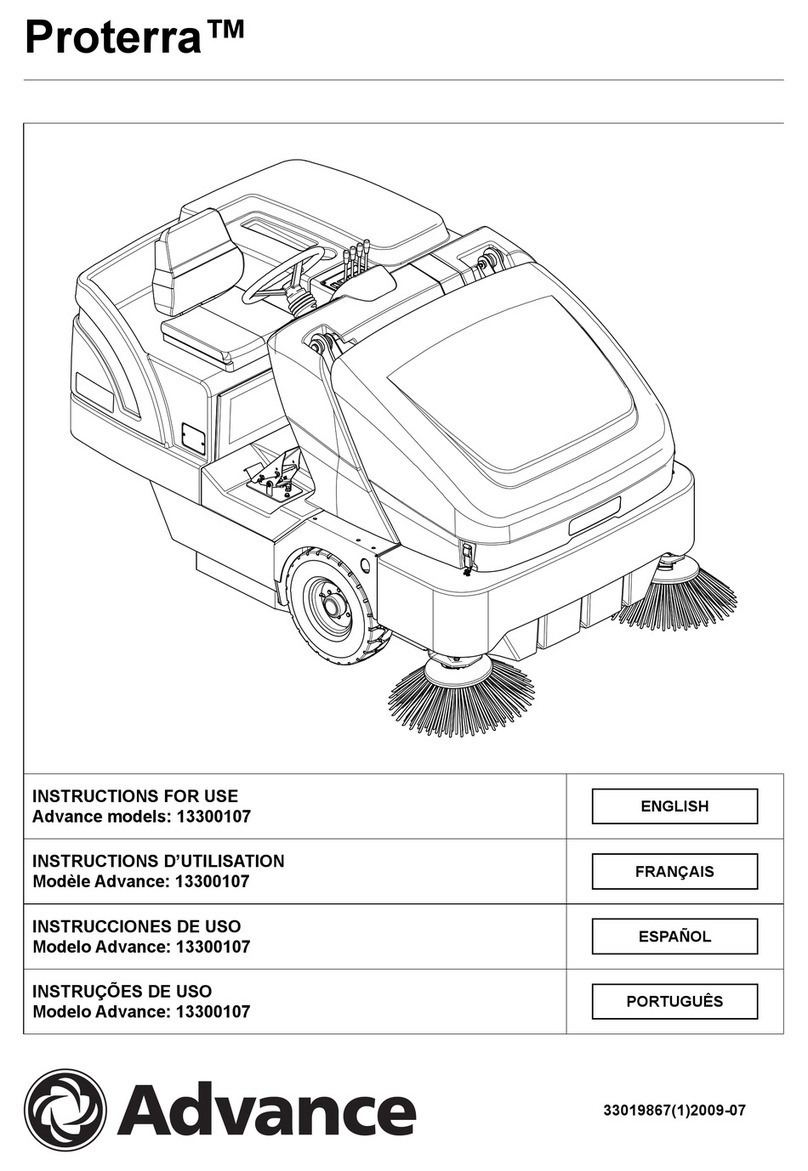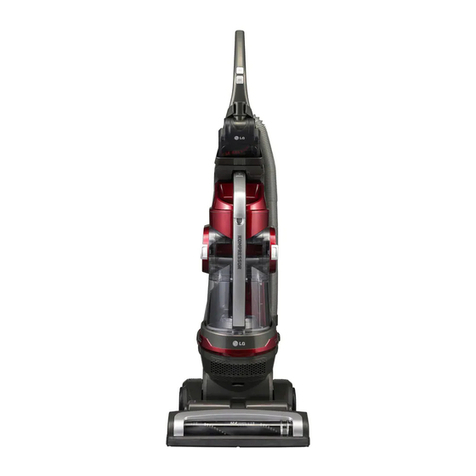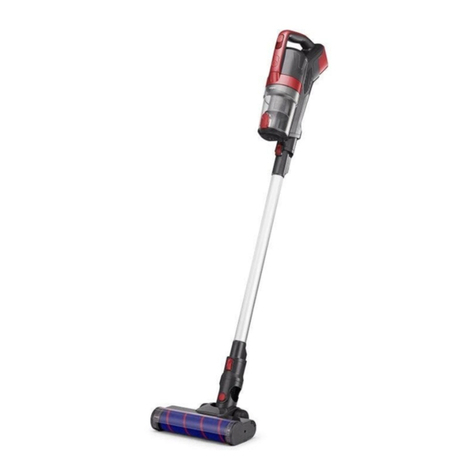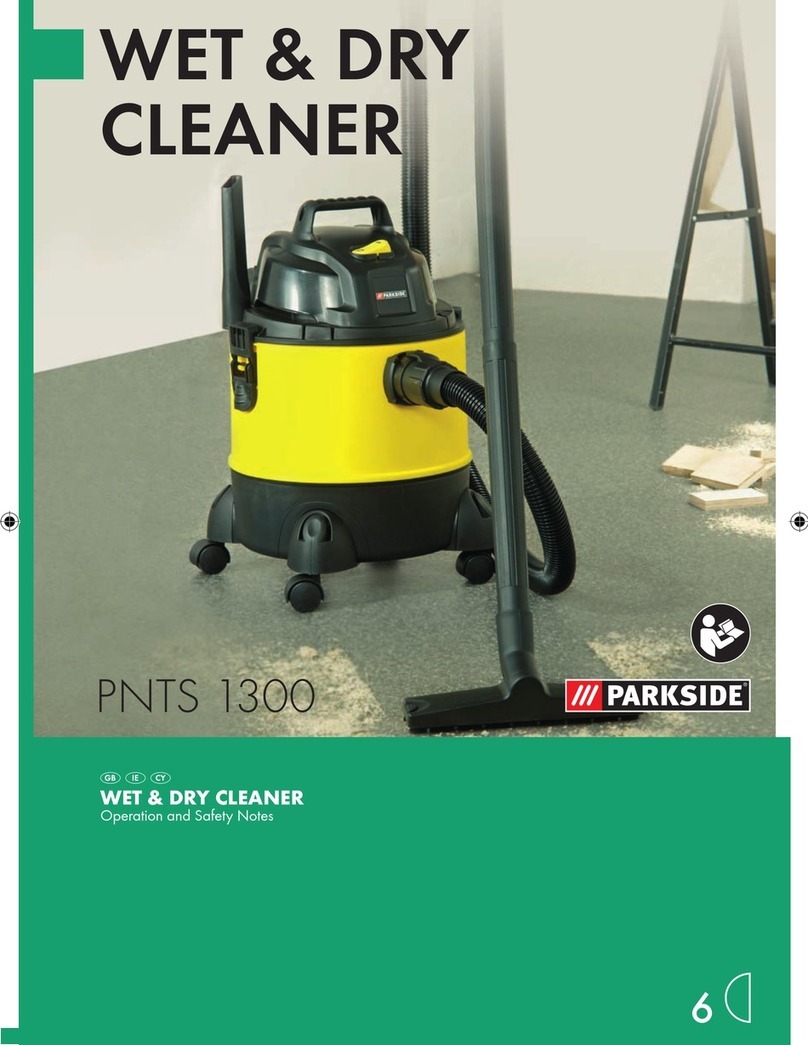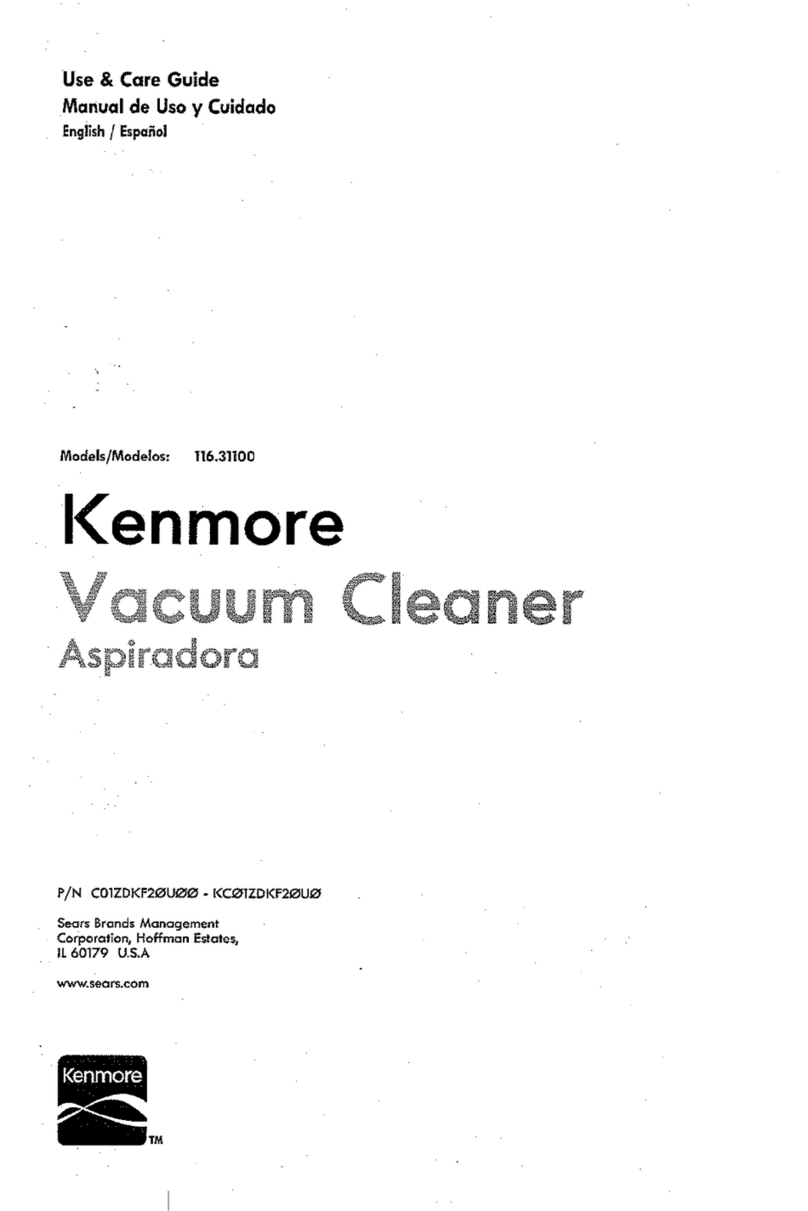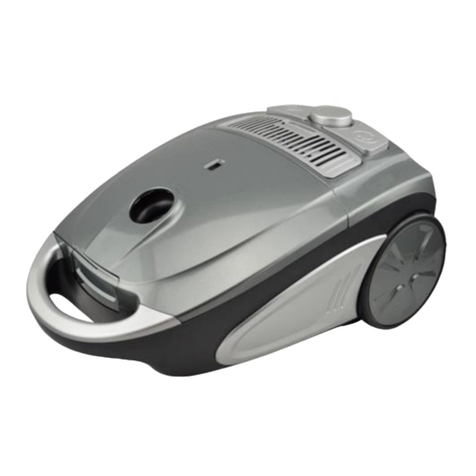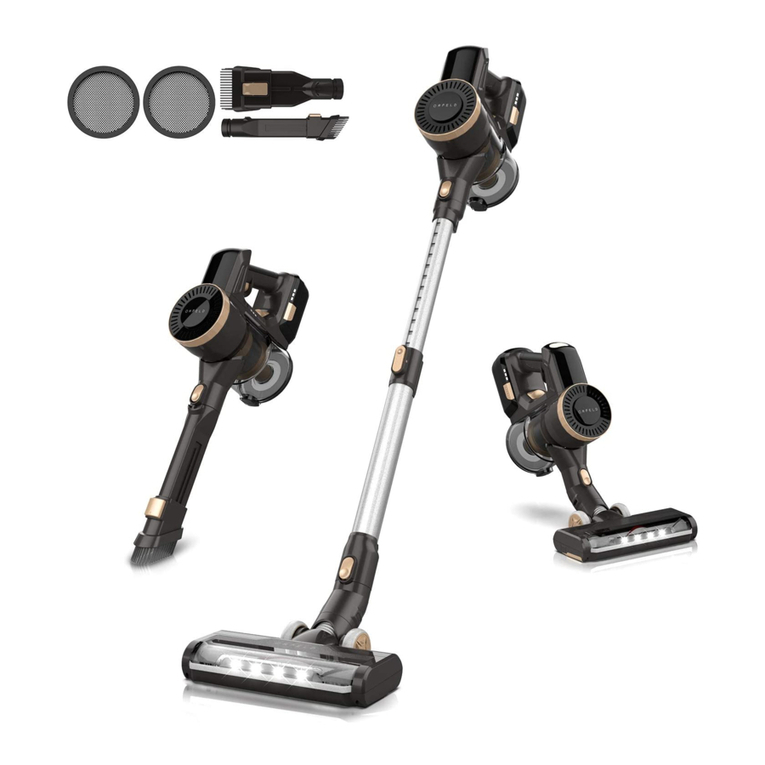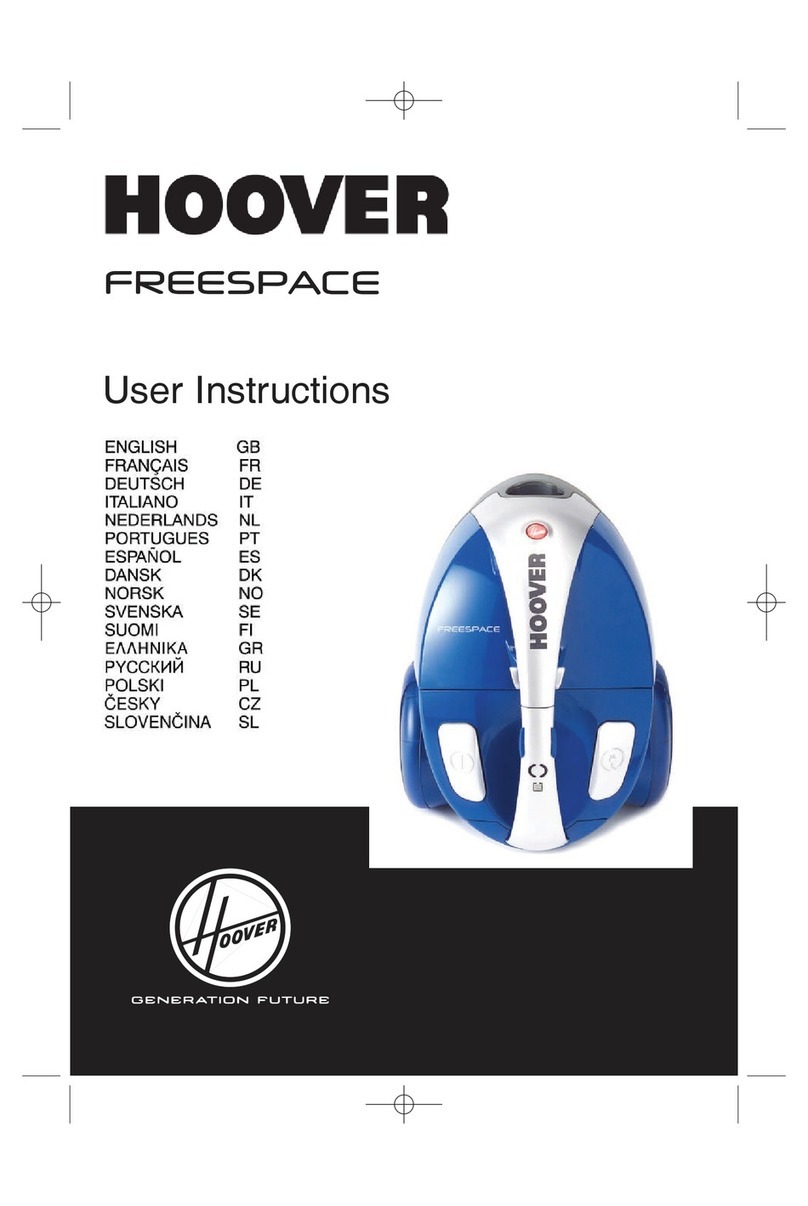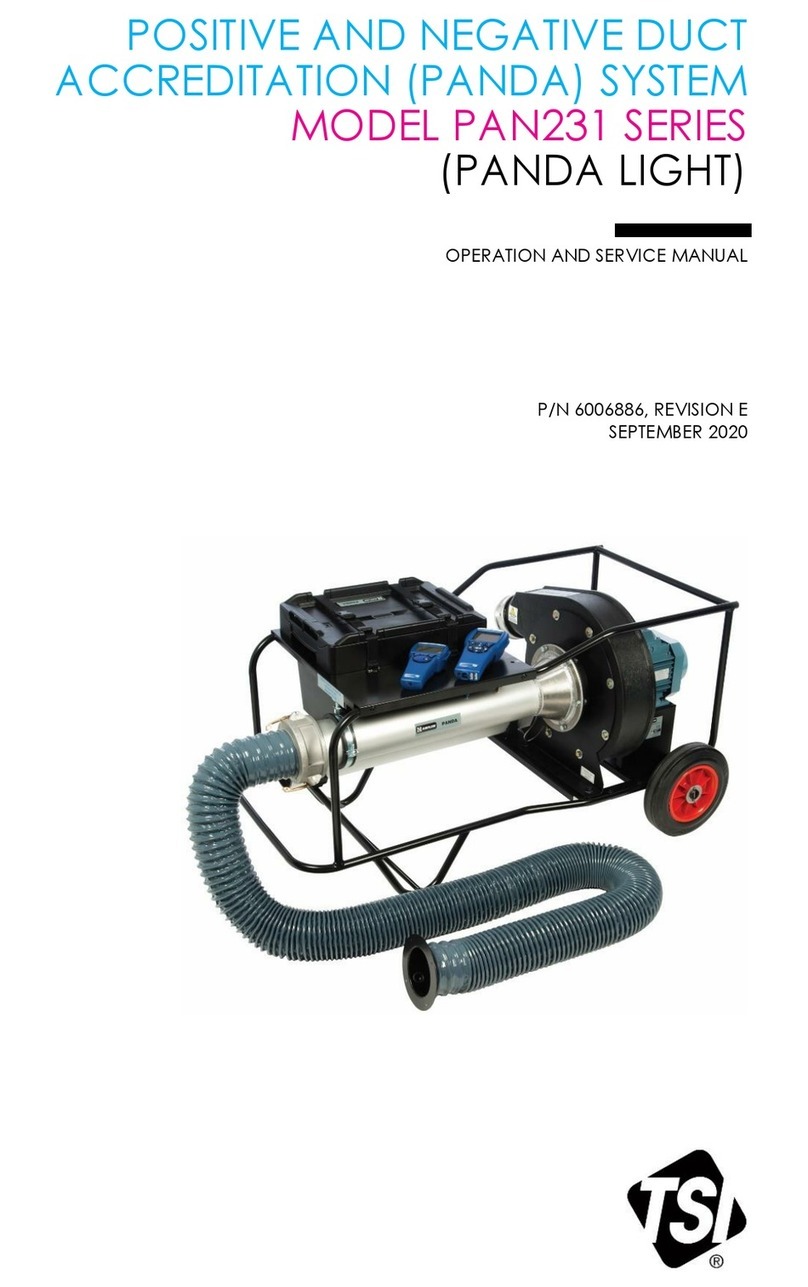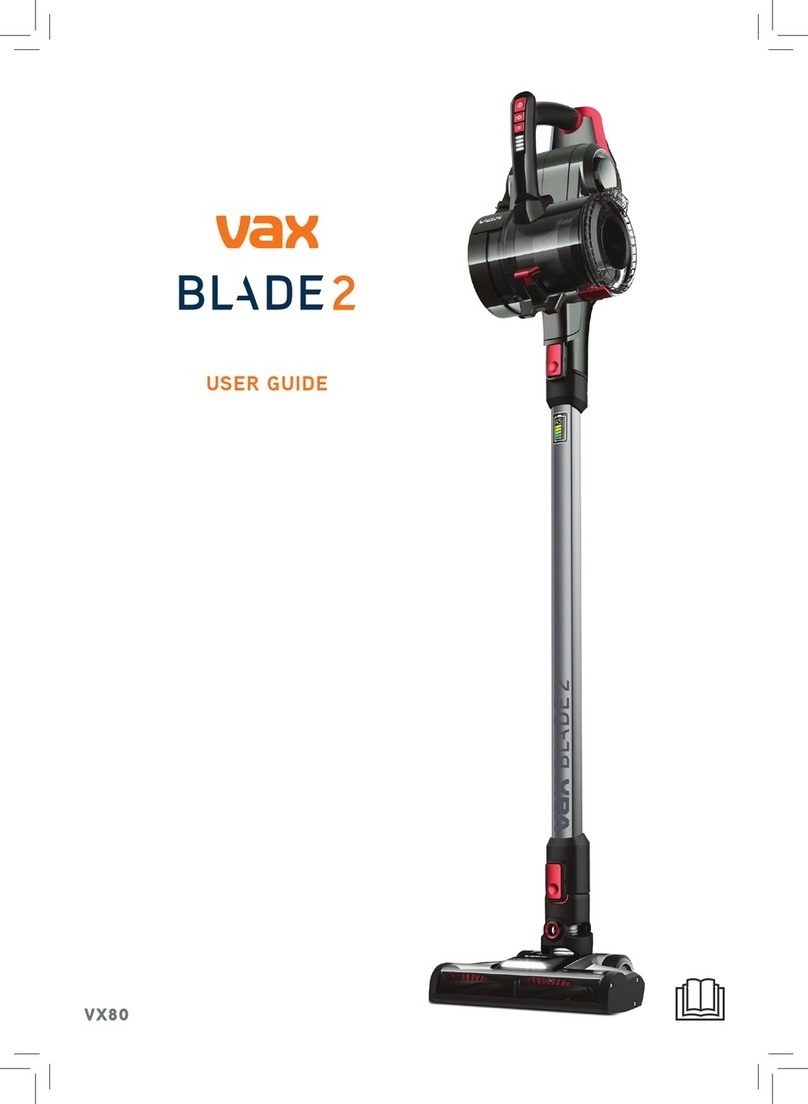Advance acoustic Turbo 56100687 User manual

2/97 revised 9/02 Form Number 56041378
English
Français
Turbo™
Instructions for use and parts listInstructions for use and parts list
Instructions for use and parts listInstructions for use and parts list
Instructions for use and parts list
Mode d’ emploi et liste de piècesMode d’ emploi et liste de pièces
Mode d’ emploi et liste de piècesMode d’ emploi et liste de pièces
Mode d’ emploi et liste de pièces
Advance MODEL 56100687(OBS), 56100745

FORM NO. 56041378 / TURBO - 1
FIG. 1 FIG. 2
FIG. 3 FIG. 4
LIMITED WARANTY
Advance warrants that the turbine powerhead, when used in a commercial application pursuant to Seller's
instructions, will be free from defects in materials and workmanship for a period of ninety (90) days from
the date of the initial consumer purchase.
Nilfisk-Advance, Inc.
14600 21 Avenue North
Plymouth, MN 55447
1-800-989-2235
1-612-745-3500

2 - FORM NO. 56041378 / TURBO
INTRODUCTION
This manual will help you get the most from your Advance Turbo. Read it thoroughly
before operating the machine.
This product is intended for commercial use only.
PARTS AND SERVICE
Repairs, when required, should be performed by your Authorized Advance Service
Center, who employs factory trained service personnel, and maintains an inventory of
Advance original replacement parts and accessories.
Call the ADVANCE DEALER named below for repair parts or service. Please specify the
Model and Serial number when discussing your machine.
(Dealer, affix service sticker here.)
NAME PLATE
The Model and Serial Number of your machine are shown on the Nameplate on the right
side of the machine. This information is needed when ordering repair parts for the
machine. Use the space below to note the Model and Serial Number of your machine for
future reference.
MODEL
SERIAL NUMBER
UNCRATING THE MACHINE
When the machine is delivered, carefully inspect the shipping carton and the machine for
damage. If damage is evident, save the shipping carton so that it can be inspected.
Contact the Advance Customer Service Department immediately to file a freight damage
claim.
SAFETY PRECAUTIONS
1Keep hair, hands and feet away from rotating brush while the Turbine Powerhead
is running.
2Remember that Turbine Powerheads operate whenever they are connected to a
running vacuum. If children are present, make sure to turn vacuum system OFF
when leaving Powerhead unit unattended.
3Do not attempt to service or unclog tool while unit is running.
4Avoid picking up water or spilled liquids with a Turbine Powerhead. The vacuum
system is designed for dry pick-up only.
INSTRUCTION FOR TURBINE POWERHEAD
(A) ATTACHING THE TURBINE POWERHEAD
Toattachyourmetalwand,simplytwistintoPowerheadelbowuntilitfitssnugly. Thebuilt-
in, locking mechanism will prevent the wand from coming loose from your Powerhead
while in use. To detach wand, depress tab on side of elbow and twist wand free. (See Fig.
1)
The wand can be locked in an upright position by pushing it forward until the lock is
engaged. (See Fig. 2). This locked position is convenient for storage and for lifting of the
Powerhead. To release wand from the vertical locked position, gently place foot on
Powerhead, grasp wand and pull back firmly.
(B) OPERATING PROCEDURES
Your Turbine Powerhead has no ON/OFF switch. Whenever it is attached to an operating
vacuum system, it will be running. No adjustments to the tool are necessary for different
types of carpeting.
Toensuremaximumefficiency of the Turbine Powerhead, make surethatanyfilters, bags
and cleaning hoses in your vacuum are clean and free of blockage.
(C) CLEARING INTAKE NOZZLE
If the Turbine or intake nozzle became obstructed:
1Turn off Vacuum System and disconnect the Powerhead from wand and hose.
2Turn Powerhead over, and remove the clear belt cover, by first rotating the two
latches counter clockwise until they align with the openings in the belt cover. Pull
the belt cover away from the housing using the tab provided, then pull the belt cover
out from under the baseplate. (See Fig. 3)
3Remove debris from the intake or turbine. Rotate brush to ensure the system is
clear. Ensure the special red colored seal and mating surfaces are clean and free
of any dirt particles, before re-assembling belt cover to unit.
4To re-assemble the belt cover to the unit: insert the front of the belt cover under the
base plate edge and press the belt cover into the housing.
5Check that a proper seal is made: UNIT PERFORMANCE IS DEPENDENT ON A
PROPER SEAL!
6Secure the belt cover in place by rotating the two latches clockwise to the locked
position.
(D) CLEANING BRUSH
Turn off vacuum system and disconnect Powerhead.
Threads,string,carpetfiber,fuzz,etc.occasionallymaybecomewoundaroundthebeater
brush. These should be removed by unwinding them by hand or carefully cutting with
scissors or other cutting tool. Keeping the beater brush clean will maintain efficiency.
(E) REMOVING THE DRIVE BELT AND BRUSH
“ItisrecommendedthisprocedurebeperformedbyaQualifiedServiceTechnician.”
Should the drive belt or brush become clogged with debris or need replacing:
1Turn off Vacuum System and disconnect Powerhead.
2Remove belt cover as described in procedure C.
3Remove the 3 screws securing the metal baseplate. (See Fig. 4)
4Lift front of baseplate up from bumper, then pull baseplate free or unit.
5Stubborn debris may now be easily removed from the brush area.
6PLEASE NOTE: Correct brush and belt orientation; they must be re-installed
correctly for proper function.
7Slide the belt up off the end of the drive shaft.
8Partially remove the bumper by lifting it free from the front and sides of the housing.
9Lift the lower belt shroud, brush, belt and support assembly out of the housing and
remove the belt from the brush. Leave upper belt shroud installed in the housing,
unless stubborn debris remains lodged below it.
10 (IF REPLACING BRUSH). Pull the right brush support (marked “R”) off the
assembly and remove the brush from the shaft.
11 Slidereplacementbrushontotheshaftsothelargetaperedrecessatoneendofthe
brush goes on first and fits over the 4 ribs on the shaft support.
12 Pushthe rightshaftsupport (marked“R”)onto theshaftextendingthrough thebrush
and check that the brush spins freely when rotated.
13 Place the belt over one end, onto the brush.
14 Slide the brush/belt assembly back into the housing recesses so the supports seat
properly into the housing.
NOTE: The housing and supports are marked L and R and must be assembled
accordingly. The ARROWS on the shaft supports must point toward the rear of the
unit,whenfittinga newbelt. Thesupportscanbe rotatedtopoint thearrowsforward
toincreasebelttensionafterextensiveuse(typicallyseveralhundredhoursofuse).
15 Place the lower belt shroud into the housing, over top of the brush pulley, as shown
in Fig. 4. Ensure that the top of the shroud cylindrical portion is flush with the upper
housing screw boss.
16 Stretch the bumper around the housing, over the shaft supports and press the
bumper into place.
17 Pull the belt gently up against the pulley teeth and over the idler bearing. Twist the
end of the belt 90°to the right as illustrated on the lower housing and press the belt
over the teeth of the drive shaft.
NOTE: The brush will rotate in the wrong direction and belt damage may occur if
the belt is twisted incorrectly.
18 Tilt baseplate to the rear of the brush area and insert the three tabs into the mating
slots in the lower housing. Rotate the front of the base down so it seats into the
groove in the bumper.
19 Replace the three screws and tighten to secure the base.
20 Replace the belt cover as described in procedure “C”.
ENGLISH

FORM NO. 56041378 / TURBO - 3
FRANÇAIS
INTRODUCTION
Ce mode d´emploi vous permettra de tirer le meilleur de votre Advance Turbo, Lisez
le attentivement avant d´utiliser la machine.
Ce produit est destiné à l´usage industriel uniquement.
PIECES ET ENTRETIEN
Les réparations, lorsque nécessaires, devront être exécutées par votre centre de
service Advance autorisé, qui emploie du personnel de service formé en usine, et
maintient un inventaire de pièces de remplacement originales et d´accessoires
d´Advance. Appelez le DETAILLANT INDUSTRIEL ADVANCE ci-dessous pour toute
réparation, pièces ou entretien. Veuillez spécifier le modèle et le numéro de série
lorsque vous parlez de votre machine.
(Détaillant, appliquer l´auto-collant de service ici.)
PLAQUE D´IDENTIFICATION
Le numéro du modèle et le numéro de série de votre machine sont inscris sur la
plaque d´identification sur la machine. Cette information est nécessaire lors de la
commande de pièces de réparation pour la machine. Utilisez la place ci-dessous pour
inscrire le numéro du modèle et le numéro de série de votre machine pour toute
référence future.
NUMERO DU MODELE
NUMERO DE SERIE
DEBALLER LA MACHINE
Lors de la livraison, inspectez attentivement l´emballage de transport et la machine
pour tout dommage. Si la détérioration est évidente, conservez l´emballage de
transport pour qu´il soit inspecté. Contactez le Bureau du Service Clientèle Advance
immédiatement pour remplir une réclamation de dommage de fret.
CONSEILS DE SÉCURITÉ
1Éloigner les cheveux, les mains et les pieds de la brosse rotative lorsque l’appareil
est en marche.
2Se rappeler que l’électrobrosse se met à tourner dès qu’elle est raccordée à
unaspirateur en marche. En présence d’enfants, s’assurer que l’aspirateur est
éteint avant de laisser l’électrobrosse sans surveilllance.
3Ne jamais tenter de réparer l’appareil ou d’en déboucher la buse d’aspiration
lorsqu’il est en marche.
4Prendre soin de ne pas aspirer des liquides, car l’électrobrosse à turbine n’est
conçue que pour aspirer des matières sèches.
UTILISATION DE L’ÉLECTROBROSSE À TURBINE D’ENTRAÎNEMENT
(A) RACCORD DU MANCHE SUR L’ÉLECTROBROSSE À TURBINE
Pour raccorder le manche en métal, l’introduire dans le coude de l’électrobrosse en le
faisant tourner jusqu’à ce qu’il soit parfaitement emboîté dans le coude. Le mécanisme
d’enclenchementà même labrosseempêchele manchedes’endégager. Pour démonter
le manche, appuyer sur la patte sur le côté du coude et faire tourner le manche en
tirantdessus (voir la fig. 1).
II est possible de bloquer le manche dans la position verticale. II suffit de le pousser vers
l’avant jusqu’à ce qu’il s’enclenche (voir la fig. 2). Le blocage dans cette position favorise
tantlerangementquele démontagedelabrosse. Pourdébloquerlemanchedelaposition
verticale, appuyer légèrement le pied sur la brosse, saisir le manche et tirer dessus
fermement vers l’arrière.
(B) UTILISATION
L’électrobrosse à turbine n’a pas d’interrupteur. Dès qu’on la branche sur un aspirateur
en marche, la brosse se met à tourner immédiatement. Aucun réglage n’est nécessaire
pour différents types de tapis.
Pouroptimiserl’efficacitédel’électrobrosseàturbine,veilleràcequefiltres,sacsettuyaux
d’aspiration de l’aspirateur soient propes et libres d’obstructions.
(C) POUR DÉBOUCHER LA BUSE D’ASPIRATION
1Fermer l’aspirateur et en séparer l’électrobrosse.
2Placer l’électrobrosse à l’envers et retirer le carter transparent de la courroie en
faisant d’abord tourner dans le sens antihoraire les deux pattes de fixation jusqu’à
ce qu’elles s’alignent sur les ouvertures du carter. Tirer sur le carter à l’aide de la
patte prévue à cet effet et le dégager la plaque inférieure. (voir la fig. 3)
3Enlever les saletés de la buse d’aspiration ou de la turbine. Faire tourner la brosse
pour s’assurer que le système est libre de tout débris. S’assurer que le joint
d’étanchéité rouge et les surfaces sur lesquelles il s’appuie sont propres avant de
remettre le carter sur l’appareil.
4Remonter le carter en introduisant le devant du carter sous le rebord de la plaque
d’appui et enfoncer le carter dans le boîtier de l’appareil.
5S’assurerdel’étanchéitédel’assemblage CARLERENDEMENTDEL’APPAREIL
DÉPEND DE L’ÉTANCHÉiTÉ DE L’ASSEMBLAGE!
6Fixer le carter en place en faisant tourner les deux pattes de fixation dans le sens
horaire jusqu’à ce qu’elles s’enclenchement.
(D) NETTOYAGE DE LA BROSSE BATTEUSE
Fermer l’aspirateur et en séparer l’électrobrosse.
Fils, ficelles, fibres de tapis, cheveux et autres matrières du genre s’enroulent parfois
autour de la brosse batteuse. II faut les enlever en les déroulant ou en les coupant avec
soin à l’aide de ciseaux ou d’un outil tranchant quelconque. Le fait de veiller à la propreté
de la brosse batteuse favorisera l’efficacité de la brosse.
(E) REMPLACEMENT DE LA COURROIE D’ENTRAÎNEMENT
Si la courroie d’entraînement de la brosse à turbine se séparait des poulles:
1Mettre l’aspirateur hors circuit et débrancher l’électrobrosse.
2Retirer le carter de la manière décrite à l’étape C.
3Enlever les trois vis retenant la plaque d’appui métallique. (voir la fig. 4)
4Détacher la partie avant de la plaque en la soulevant du pare-chocs et l’enlever.
5On peut alors enlever facilement les débris tenaces sur la brosse.
6NOTA: Remarquerlesenscorrectd’installationdelabrosseetdelacourroie;ilfaut
les réinstaller correctement afin d’assurer le bon fonctionnement de l’appareil.
7Faire glisser la courroie hors de l’extrémité de l’arbre d’entraînement.
8Enlever le pare-chocs en partie en le soulevant hors des côtés avant et latéraux du
boîtier.
9Soulever l’assemblage brosse-courroie-arbre hors du boîtier, et enlever la courroie
de la brosse.
10 (POUR REMONTER LA BROSSE). Enlever le support droit de la brosse (portant
l’indication R) de l’assemblage et retirer la brosse de l’arbre.
11 Faireglisserlabrossederechangesurl’arbreenpassantd’abordlegroscreuxsitué
à une extrémité de la brosse et en l’insérant dans les quatre rainures du support de
l’arbre.
12 Faire glisser le support droit de l’arbre (portant l’indication R) sur l’extrémité de
l’arbre qui dépasse de la brosse et s’assurer que cette dernière tourne librement.
13 Placer la courroie sur une extrémité de la brosse.
14 Faireglisserl’assemblagebrosse-courroiedansl’espaceprévuàceteffetduboîtier
de manière que les supports reposent convenablement dans le boîtier.
NOTA: Les supports et le boîtier portent les indications R et L; il faut aligner les
indications correspondantes. Les flèches des supports de l’arbre devraient pointer
vers l’arrière de l’appareil lorsqu’on met en place une nouvelle courroie. Les
supportspeuventêtretournésaveclesflèchesversl’avantlorsqu’onveutaugmenter
latension delacourroieaprès un usageintensif(habituellementplusieurs certaines
d’heures d’utilisation).
15 Placer le protecteur inférieur de la courroie dans le boîtier, au-dessus de la poulie
de la brosse, comme le montre la figure 4 plus bas. S’assurer que le dessus de la
portioncylindrique du protecteur arrive à égalité aveclemoyeuduboîtiersupérieur.
16 Placer le pare-chocs autour du boîtier et par-dessus les supports de l’arbre, puis
l’enfoncer en place.
17 Placer la courroie contre les dents de la poulie et au-dessus du tendeur. Faire
tourner de 90°l’extrémité de la courroie, comme illustré sur la partie inférieure du
boîtier et appuyer la courroie contre les dents de l’arbre d’entraînement.
NOTA: La brosse tourne dans le mauvais sens si la courroie n’est pas bien tordue,
et cela peut endommager la courroie.
18 Faire basculer la plaque jusqu’à la zone de la brosse et insérer les trois pattes de
fixation dans les fentes prévues à cet effet du boîtier inférieur. Faire tourner le
devant de la plaque vers le bas afin qu’il repose dans la rainure du pare-chocs.
19 Remettre les trois vis en place et les fixer à la plaque inférieure.
20 Remettre le carter de la courroie en place comme le décrit l’étape C.

FORM NO. 56041378
4
1
1
2
3
4
5
6
7
8
9
10
11
12
12
13
14

FORM NO. 56041378
5
TURBO POWERHEAD
Item Part No. Qty Description
156105600 2 Wheel
256105601 1 Turbine (Impeller)
356105602 1 Belt Cover
456105603 1 Washer, Elbow Seal
556105604 1 Elbow
656105605 1 Retainer Cap
756105606 1 Bumper
8 56100689 1 Brush
956100690 1 Belt
10 56105607 1 Bearing, Needle
11 56105608 1 Idler Shaft
12 56105609 2 Sleeve, Flange
13 56105610 1 Shaft Support
14 56105611 1 RT Shaft Support
Optional Accessory Wands
*56204229 1 Wand, Chrome 54", two bend, 1 piece, Spec. 1-1/4"Dia. to 1-1/2"Dia.
*56204232 1 Wand Kit, 3 piece, Spec. 1-1/4"Dia. to 1-1/2"Dia.
*56204230 1 Elbow, Gray Plastic 11" (included in Wand Kit)
*56204231 2 Wand, Gray Plastic 20" (included in Wand Kit)
*56105510 1 Reducer, Spec. 1-1/4"Dia. to 1-1/2"Dia. NOTE: 1
NOTE: 1 The reducer is used to adapt the turbo head (1-1/4" ID) inlet elbow
to the following listed 1-1/2" Dia. Wands.
*56209234 1 Chrome Wand 54", two piece, two bend
*56409563 1 Steel Wand 54", two piece, two bend
*56100368 1 Plastic Wand 54"(Gray), one piece. two bend
*56701094 1 Plastic Wand 54"(Black), one piece. two bend
* = Not Shown
revised 3/99

Nilfisk-Advance, Inc.
14600 21st Avenue North
Plymouth, MN, 55447-3408
www.nilfisk-advance.com
Phone: 800-989-2235
Fax: 800-989-6566
©2002Nilfisk-Advance, Inc.,
Plymouth, MN 55447-3408
Printed in the U.S.A.
This manual suits for next models
1
Table of contents
Languages:
Other Advance acoustic Vacuum Cleaner manuals

Advance acoustic
Advance acoustic SC100 Instruction Manual

Advance acoustic
Advance acoustic VacRide3400C User manual

Advance acoustic
Advance acoustic AdVac 11 User manual

Advance acoustic
Advance acoustic VU500 12 INCH SMU US User manual

Advance acoustic
Advance acoustic QuickStar B Guide

Advance acoustic
Advance acoustic VU500 15 INCH SMU US User manual
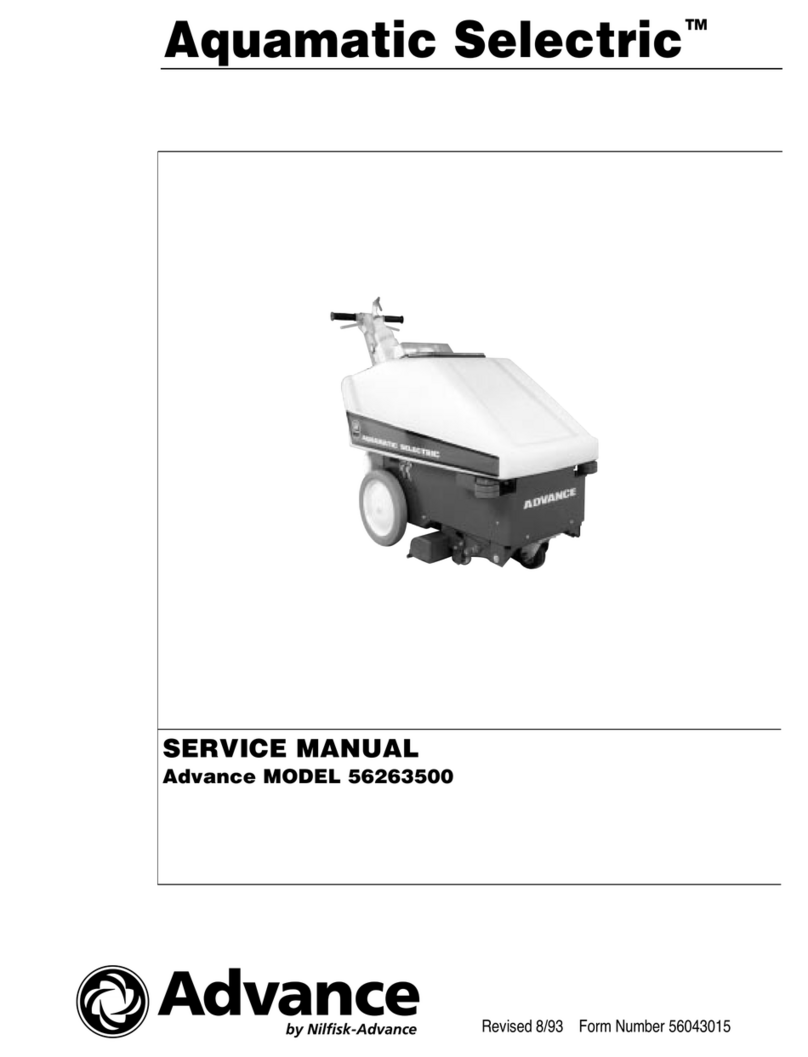
Advance acoustic
Advance acoustic Aquamatic Selectric User manual

Advance acoustic
Advance acoustic Adgility 6XP User manual

Advance acoustic
Advance acoustic L/A 114 User manual
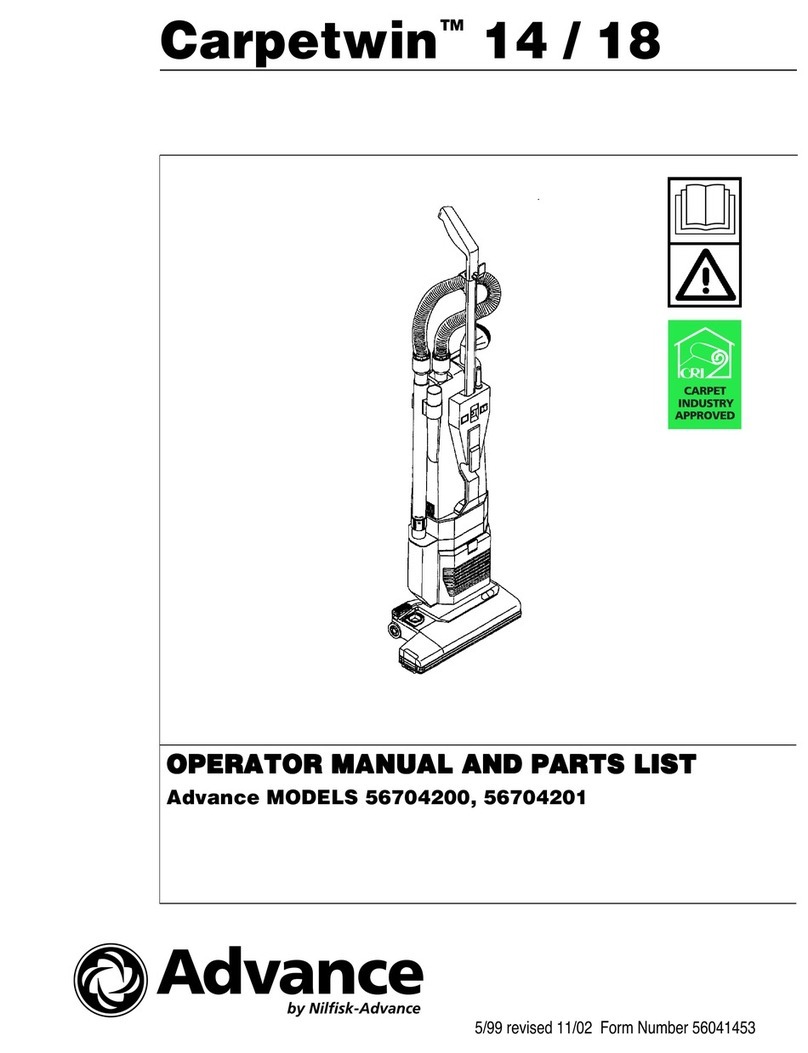
Advance acoustic
Advance acoustic Carpetwin 56704200 User manual


